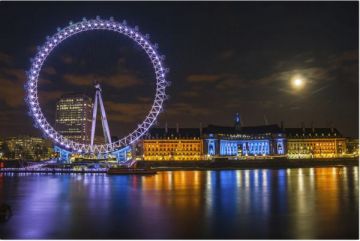by Michael J Young
Alfred, Lord Tennyson has much to answer for.
He may have been a respected poet, a reluctant but noble lord, the first English writer to be awarded a hereditary title for his work. He may have been the author of many poems of great beauty and deep thought, and an early supporter of women's rights. He may have grown from humble beginnings, as one of eleven children of a clergyman, to become Britain's greatest poet of the second half of the 19th century.
His appointment in 1850, by Her Majesty Queen Victoria, Queen of Great Britain and Ireland and Empress of India, as Poet Laureate, a position he held until his death 42 years later, was certainly widely popular and regarded by many as richly deserved.
Yet, this is the man whose writings almost single-handedly launched the modern myth movement that surrounds the legendary 5th/6th century King Arthur, his court at Camelot, Guinevere, Merlin the Magician, Sir Lancelot and the other Knights of the Round Table, and the quest for the Holy Grail - to mention just a few aspects - that are at the heart of today's worldwide Arthurian industry.
The study of the Arthurian legends brings together scholars, academics, romantics, realists, writers, educationalists, new agers, publishers, researchers and many others, in a whirlpool of theories, symbols, disputed facts, speculation, conjecture, individual interpretation and on-going investigation.
Idylls of the King
Amongst the very latest manifestations of this quest for Arthurian truth are the recollections of more than a hundred people who under regressive hypnotherapy revealed previous lives in Camelot, 1500 years after the actual period. The "Big Bang" that gave rise to the widespread modern interest and examination of the legends, was Tennyson's epic story about King Arthur and Camelot, the beautifully written Idylls of the King.
The first of these 12 Arthurian poems was published in 1859. Tennyson's poetic development of the legends that sprang from the Celtic origins of Camelot - believed by some to have been located at Caerleon-on-Usk, in what is now South Wales, or as proposed by Sir Thomas Malory, in his 15th-century literary work "Le Morte d'Arthur", in Winchester, Hampshire - was not well received by some mid-19th century critics.
But the Idylls proved enormously popular with the public and have been the source of great interest and study ever since.
The lack of factual and physical evidence to prove anything beyond argument has long resulted in a plethora of theories about Camelot and its legendary protagonists. Fewer facts inevitably spell more conjecture and supposition. It's not surprising then that many mythical connections with the Arthurian legends are encountered throughout southern Britain.
Camelot?
These range from the 12th-century identification of Glastonbury, near Wells, in Somerset, as Avalon, the burial place of King Arthur, through to a claimed location for London's Camelot on the northern edge of rural Trent Park, by Enfield Chase - a thousand years ago the hunting territory of the Kings of England - and close to the present North London border of the Enfield and Barnet boroughs.
The location, which has been described as "an ancient and mysterious archaeological site", is known today as Camelot Castle and Camlet Moat. These names go back many centuries although the dates of usage of the names are unclear.
What is clear is that there are now few remaining signs of the building reported three centuries ago, but there remains a disturbingly quiet and neglected island site surrounded by a stagnant moat. Many local legends are associated with the location and reports show that in relatively recent times Camelot and Camlet have received much attention from Arthurian seekers-after-the-truth, New Age believers, pagan worshippers and searchers for the Holy Grail.
It is interesting to note that one of the locally recorded 17th-century references to the location traces its ownership back to the family of the medieval knight Sir Geoffrey de Mandeville, Earl of Essex, stories of whom abound in the area and whose ghost has been seen to appear in the neighbourhood on several occasions over past centuries.
This connection with "The Robber Baron" is supported by a description in the novel "The Fortunes of Nigel", by one of Britain's foremost 19th-century writers and poets, Sir Walter Scott. He uses Camlet Moat as a setting in the novel, which was published in 1822; the island being described as marking "the ruins of the abode of a once illustrious, but long-forgotten family - the Mandevilles, Earls of Essex, to whom Enfield Chase and the extensive domains adjacent had belonged in elder days."
But what of associations with King Arthur? Fact and fiction mingle through all the stories associated with the legendary king and his court. And it is here that things start to get intriguing, again.
King Arthur's Tomb
In 1190 when the monks of Glastonbury claimed to have discovered the bodies of both King Arthur and Queen Guinevere, they produced as proof of the bodies' identification a leaden cross inscribed "Here lies buried the renowned King Arthur with Guinevere his second wife, in the Isle of Avalon." Many years later, in the 18th century, this cross disappeared.
The December 17th, 1981 edition of the Enfield Advertiser newspaper carried a report that an inscribed lead cross, bearing the name of King Arthur and described as "possibly a long lost amulet from the tomb of King Arthur", had been found in the grounds of Forty Hall, Enfield, just three miles from Camlet Moat. The discovery went on to receive major media attention from the Press and television in Britain and internationally.
But before positive identification could be made, a dispute over ownership broke out between the finder, Mr Derek Mahoney - who refused to part with it - and the owners of historic Forty Hall, the local Enfield Council. This dispute escalated into a court case and Mr Mahoney was sent to jail for a short spell. Soon after his release, his hanged body was found at his home by the police. A verdict of suicide was recorded by the local coroner. The cross was never recovered.
Was it the original Glastonbury cross, or a hoax? If it were genuine, where was it when missing for 300 years? How did it get across the country to a location on the doorstep of North London's Camlet Moat? These and other questions remain unanswered. Have its secrets gone with Mr Mahoney to his grave?
About the author
Michael James Young is a London, England-based writer/photographer with a special interest in travel, leisure, and recreation- tel. 020 8449 8263 / fax 020 8440 8315) - email: michael.j.young@btinternet.com - Feb 22 2001
Article © Michael J. Young


